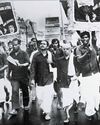Kashmir to Udaipur: Files & Lies
Outlook
|August 01, 2025
Udaipur Files is just one film. A lot more films are in the making, one worse than the other. There is a need to pause and reflect on where we are heading

ON January 18, 1933, Joseph Goebbels went to watch the film Der Rebell (The Rebel) with his mentor, Adolf Hitler, and upon returning, Goebbels, greatly impressed with how the film moved the audience, wrote in his diary, “Here you really see what can be done with the film as an artistic medium when it is really understood.” Shortly thereafter, Goebbels was appointed “minister of popular entertainment and propaganda” in the Nazi government, and films remained an important focus of his work. David Stewart Hull, in his book Film in the Third Reich, traces the transformation of German films during the Nazi era from critically acclaimed art to hate mongering propaganda. The parallels that emerge in contemporary Bollywood cinema with German films in the 1930s under the Nazi Party are stark and deeply disturbing.
As the controversy surrounding the film Udaipur Files courses its way through the judicial system, perhaps the moment is ripe to step back and see where our films are headed. There has been an increase in particular varieties of films over the course of the last decade. The first variety is hyper-nationalistic films glorifying the army, police and security agencies. Films in this genre include war films like Uri: The Surgical Strike (2019), Bhuj: The Pride of India (2021) and The Ghazi Attack (2017), which was based on submarine warfare, among others. Such films have always been produced, albeit not as frequently, and these films are otherwise unobjectionable, but are still relevant to the discussion here because coincidentally, the early days of Nazi power saw an increase in the production of nationalistic films, particularly war films, depicting German heroism in an exaggerated form. These included war films like Berge in Flammen (The Doomed Battalion, 1931), Der Rebell (The Rebel, 1932) and a drama on submarine warfare during the First World War called
Esta historia es de la edición August 01, 2025 de Outlook.
Suscríbete a Magzter GOLD para acceder a miles de historias premium seleccionadas y a más de 9000 revistas y periódicos.
¿Ya eres suscriptor? Iniciar sesión
MÁS HISTORIAS DE Outlook

Outlook
The Big Blind Spot
Caste boundaries still shape social relations in Tamil Nadu-a state long rooted in self-respect politics
8 mins
December 11, 2025

Outlook
Jat Yamla Pagla Deewana
Dharmendra's tenderness revealed itself without any threats to his masculinity. He adapted himself throughout his 65-year-long career as both a product and creature of the times he lived through
5 mins
December 11, 2025

Outlook
Fairytale of a Fallow Land
Hope Bihar can once again be that impossibly noisy village in Phanishwar Nath Renu's Parti Parikatha-divided, yes, but still capable of insisting that rights are not favours and development is more than a slogan shouted from a stage
14 mins
December 11, 2025

Outlook
The Lesser Daughters of the Goddess
The Dravidian movement waged an ideological war against the devadasi system. As former devadasis lead a new wave of resistance, the practice is quietly sustained by caste, poverty, superstition and inherited ritual
2 mins
December 11, 2025

Outlook
The Meaning of Mariadhai
After a hundred years, what has happened to the idea of self-respect in contemporary Tamil society?
5 mins
December 11, 2025

Outlook
When the State is the Killer
The war on drugs continues to be a war on the poor
5 mins
December 11, 2025

Outlook
We Are Intellectuals
A senior law officer argued in the Supreme Court that \"intellectuals\" could be more dangerous than \"ground-level terrorists\"
5 mins
December 11, 2025

Outlook
An Equal Stage
The Dravidian Movement used novels, plays, films and even politics to spread its ideology
12 mins
December 11, 2025

Outlook
The Dignity in Self-Respect
How Periyar and the Self-Respect Movement took shape in Tamil Nadu and why the state has done better than the rest of the country on many social, civil and public parameters
5 mins
December 11, 2025

Outlook
When Sukumaar Met Elakkiya
Self-respect marriage remains a force of socio-political change even a century later
7 mins
December 11, 2025
Listen
Translate
Change font size

